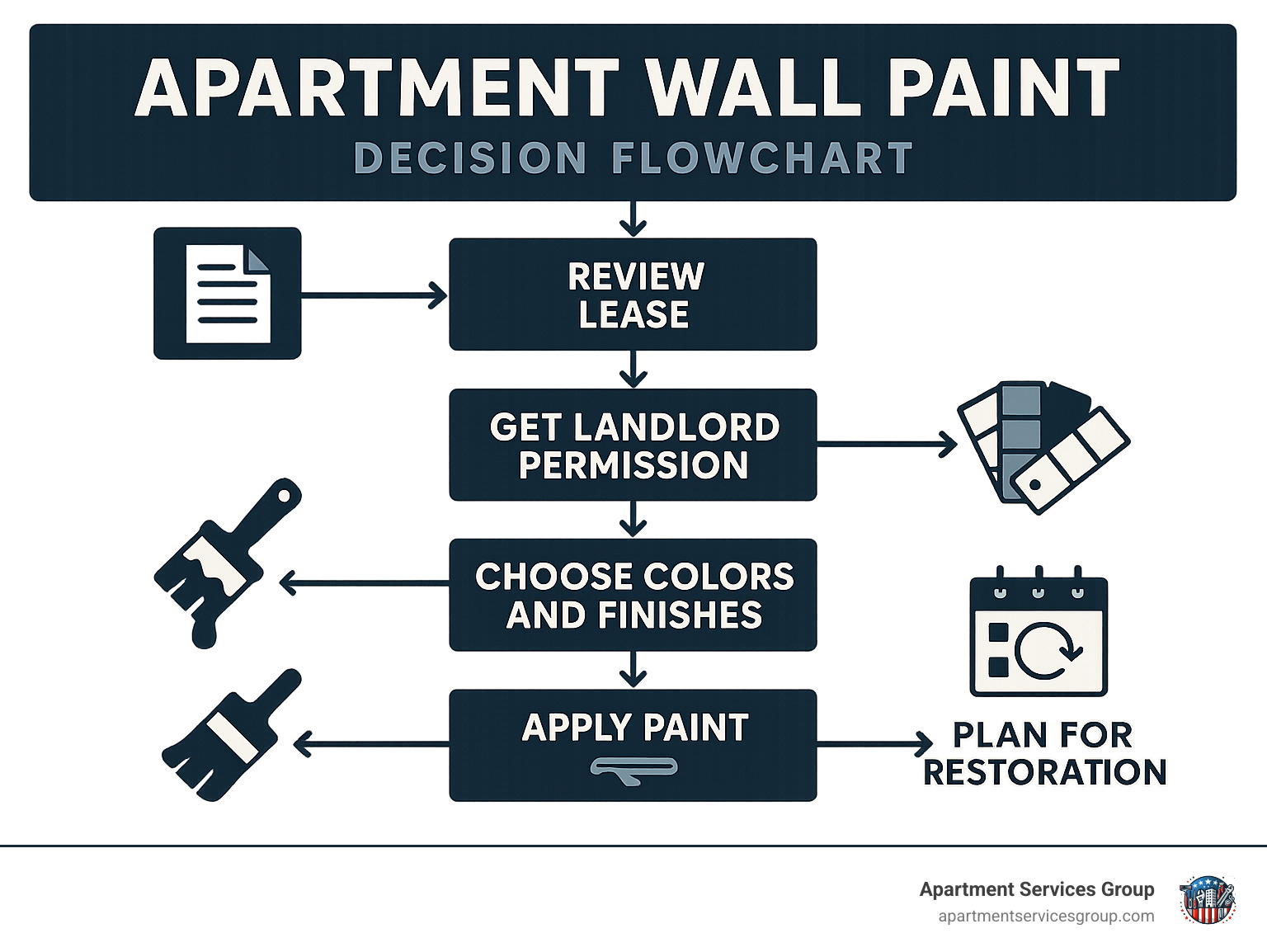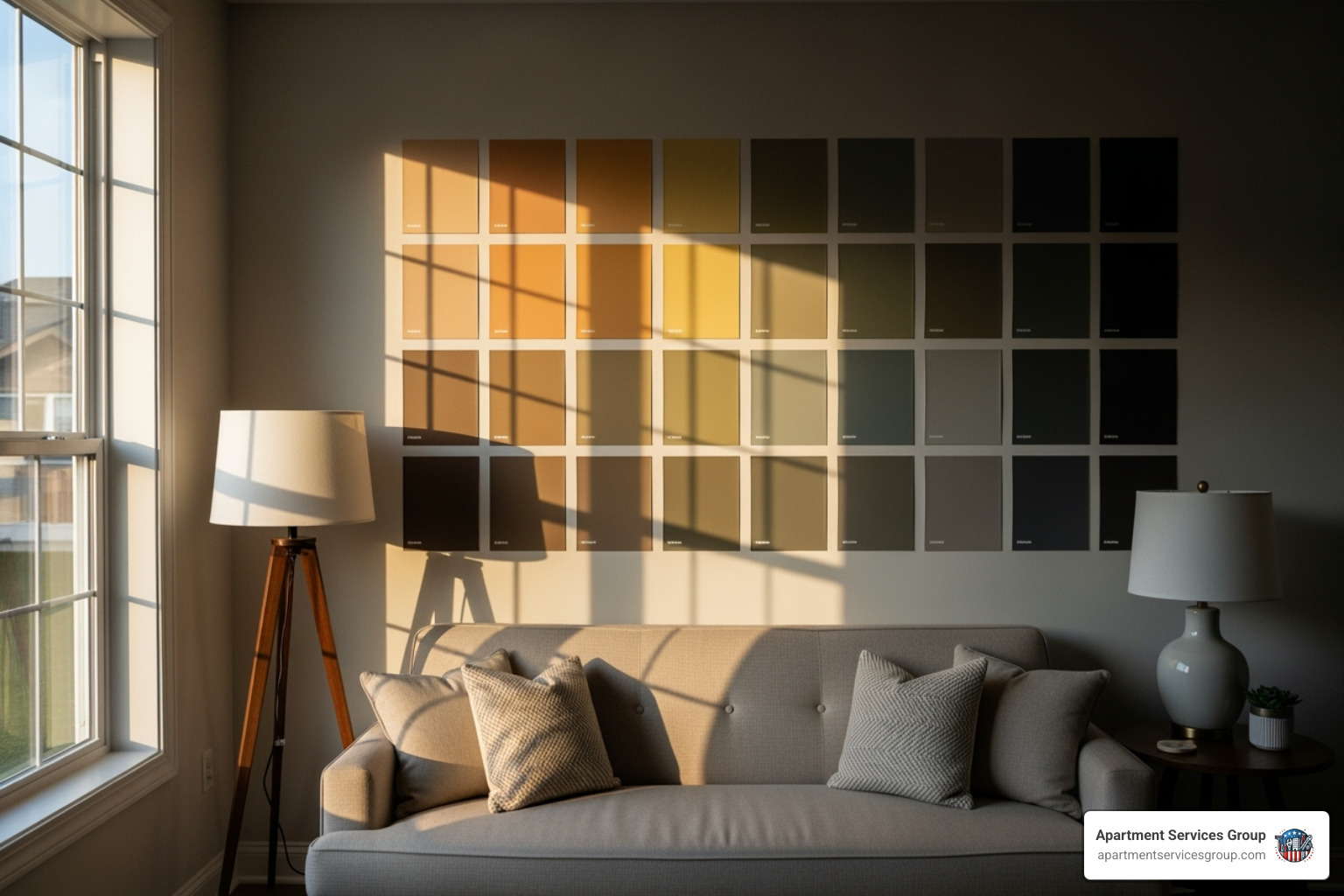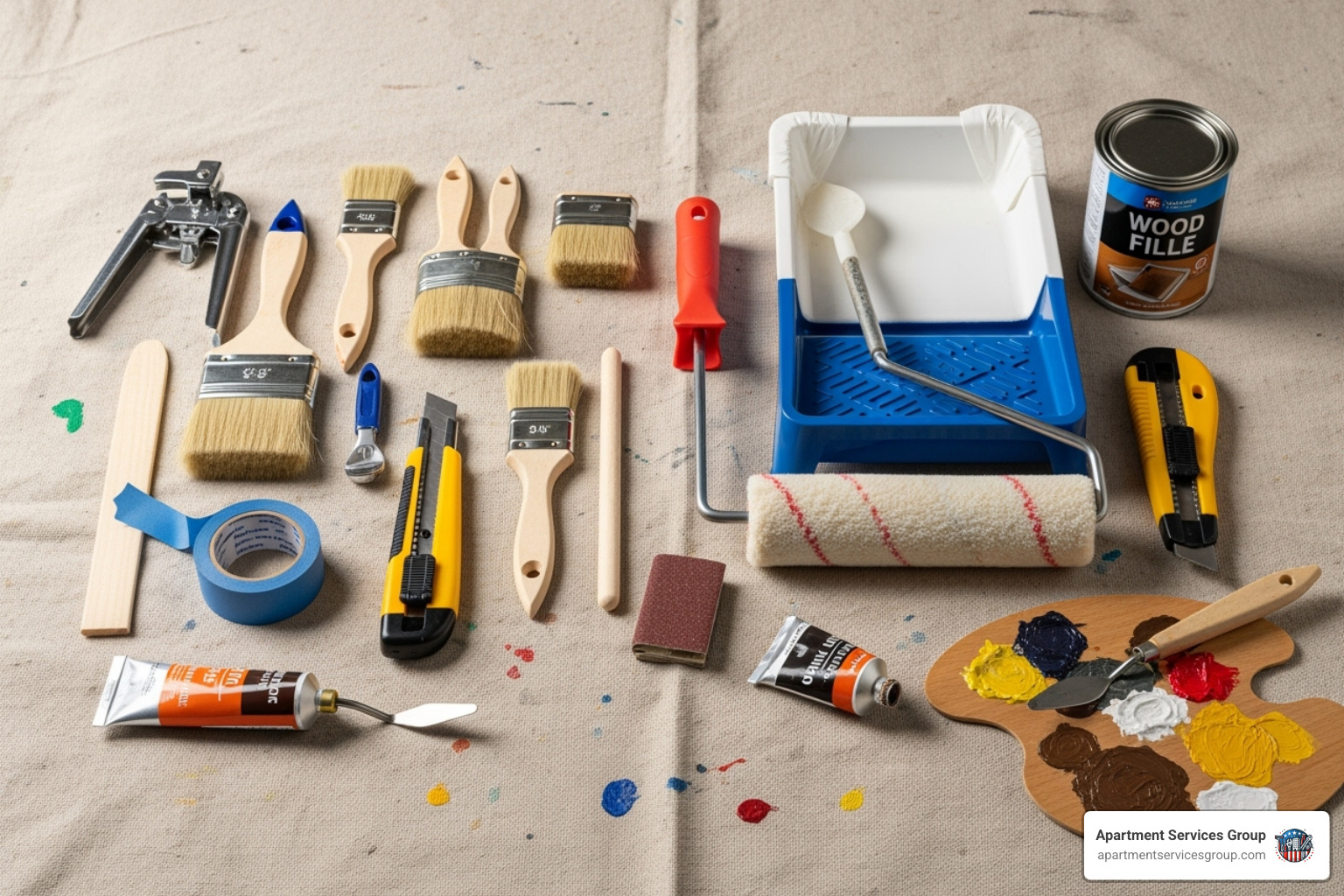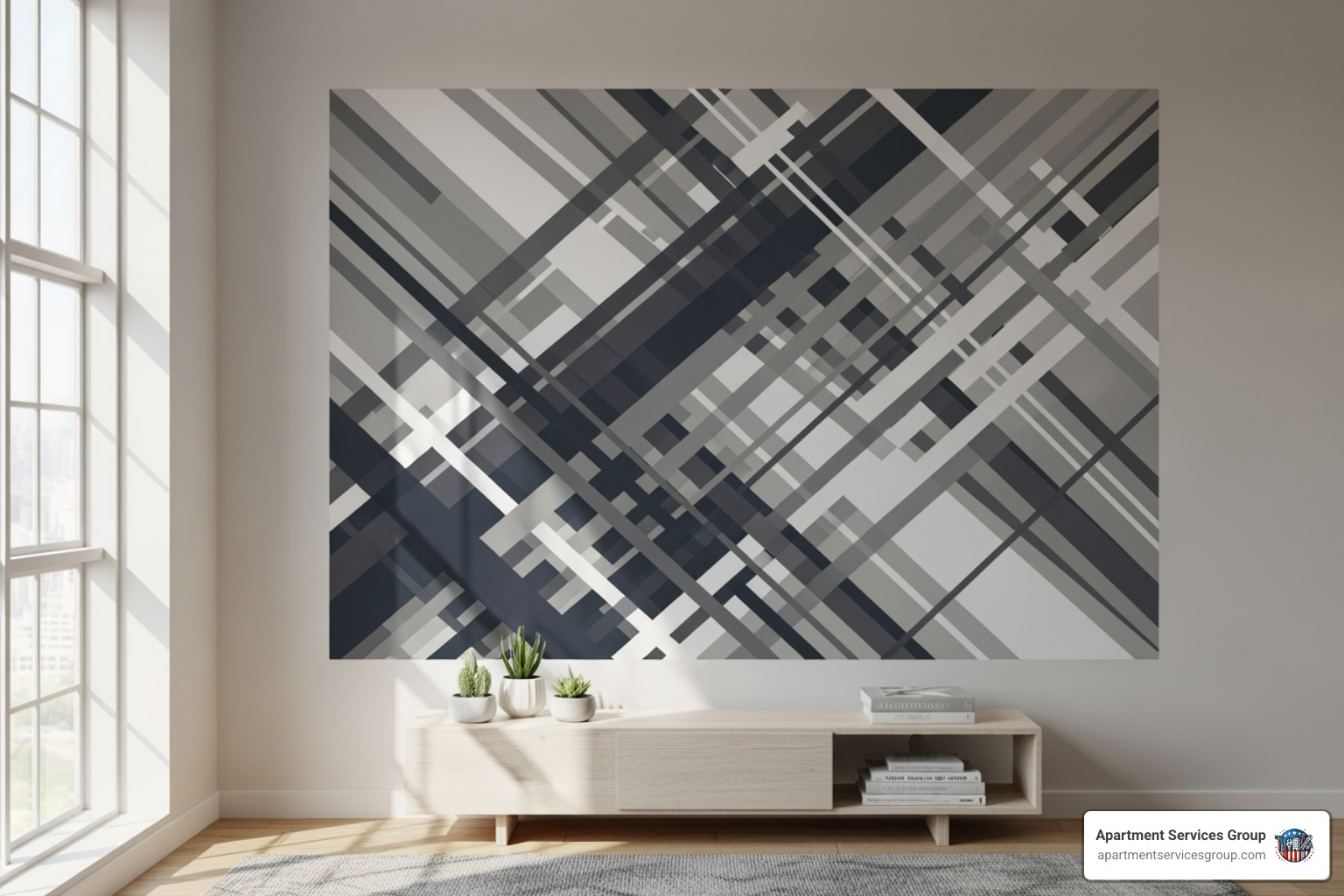Apartment wall paint: 2025 Flawless Guide
Why Apartment Wall Paint Matters for Your Living Space
Apartment wall paint can transform your living space, but the wrong approach can cost you your security deposit.
Quick Guide to Apartment Wall Paint Rules:
- Always get written permission from your landlord before painting.
- Choose neutral colors (whites, beiges, light grays) for easier restoration.
- Use quality paint finishes like eggshell or satin for durability.
- Budget for restoration to repaint to the original color when you move out.
- Consider alternatives like removable wallpaper for bold designs.
Light colors like soft white or pale blue make spaces feel larger, while strategic color choices can boost your mood. However, most leases require written permission for alterations. Painting without approval can lead to losing your security deposit, facing bills for repainting, or even legal issues.
Many landlords are open to painting if approached professionally. Some may even contribute to costs if you’re improving the property.
I’m Moe Shariff, owner of Apartment Services Group. With over eight years of experience in property renovations, I’ve seen how the right approach to apartment wall paint creates beautiful results while protecting your relationship with your landlord.
The Golden Rule: Getting Landlord Permission First
You’ve moved into a new apartment, and the bland walls are calling for a fresh coat of apartment wall paint. Before you start, remember the golden rule that can save you from serious trouble: always get your landlord’s permission first.
Skipping this step is a major risk to your security deposit and your relationship with your landlord. Your lease is a legally binding contract that almost certainly has clauses about property alterations, and painting counts as an alteration.
Many landlords are reasonable when approached professionally. They may be open to painting, especially if you offer to cover restoration costs or choose colors that improve the property’s appeal. The key is clear, written communication. Send a formal request detailing your color choices and your plan for restoration upon moving out.
Understanding Your Lease
Before dreaming of colors, read your lease. Look for sections on “property alterations,” “modifications,” or “decorating.” A “no alterations” clause means you need written consent. If the language is vague, assume the answer is “no” until you get clarification.
If you’re apartment hunting, bring up painting during pre-move-in negotiations. You might get your landlord to agree to a fresh coat before you even move in.
A pro tip: document everything when you move in. Take photos or videos of every wall, noting any existing scuffs or damage. This protects you from being charged for pre-existing issues.
The Consequences of Painting Without Approval
Painting without permission can have serious consequences. The most immediate is the loss of your security deposit, as landlords will use it to cover repainting costs. Unauthorized painting is almost always considered “damages beyond normal wear and tear.”
You could also receive a bill for professional repainting, which can be expensive. Landlords hire professionals, and covering dark colors requires extra primer and labor, increasing the cost significantly.
Beyond finances, you risk getting unfavorable landlord references, which can make it hard to find future rentals. In extreme cases, unauthorized alterations can be a lease violation that leads to legal trouble.
Respecting property management guidelines protects your finances and ensures a smoother, more enjoyable living experience.
Choosing Your Palette: Colors and Finishes for Apartment Living
With your landlord’s permission, the exciting part begins: choosing your apartment wall paint colors. This is your chance to let your personality shine. The right choice involves understanding how color, light, and mood interact in your space.
Color psychology plays a big role. Pale blue promotes relaxation, green connects us with nature, and vibrant yellows can energize a room. Natural light is also a key factor. Always test paint samples on your walls and observe them for 24 hours to see how they look in different light throughout the day.
Paint can also create focal points and define zones in an open-concept space, helping a studio apartment feel like it has separate living and sleeping areas.
Colors to Make a Small Apartment Feel Larger
Apartment wall paint is a secret weapon for making compact spaces feel larger. The magic lies in light and cool colors, which create an optical illusion of more space.
- White and off-white are classic choices that reflect light, making rooms feel bright and airy. A creamy off-white adds warmth while still maximizing the sense of space.
- Pale blue reminds us of open skies, tricking the brain into perceiving a larger area.
- Soft grays offer a sophisticated, modern backdrop that pairs well with almost any decor.
- Neutral tones like beige and greige (a mix of gray and beige) provide warmth and create a cohesive flow, making the entire apartment feel more harmonious.
Using Bold Colors and Creative Techniques
Feeling adventurous? Bold colors can add incredible depth and character, even in small apartments. Dark and dramatic colors like emerald green or navy blue can make a room feel intimate and luxurious. However, they can also overwhelm a space and are harder to paint over when you move, so landlord permission is critical.
- Accent walls are the perfect compromise. Paint one wall a vibrant color to create a focal point without overwhelming the room.
- Color blocking, or painting sections of walls in different colors, is great for defining functional zones in an open-concept layout.
- Painting trim and doors a contrasting color can add personality with less commitment.
Current trends favor earthy hues, rich jewel tones, and even maximalist palettes, proving that small spaces can handle big personality.
Best Finishes for Your Apartment Wall Paint
Choosing the right paint finish is as important as the color. The finish affects durability, cleanability, and how the color appears.
| Finish | Durability | Sheen | Best For | Ease of Cleaning |
|---|---|---|---|---|
| Matte/Flat | Low | No sheen, absorbs light | Ceilings, low-traffic areas, hides imperfections | Difficult to clean, prone to scuffs |
| Eggshell | Medium | Low sheen, like an eggshell | Bedrooms, living rooms, dining rooms, hallways | Easy to wipe clean, good balance of durability and appearance |
| Satin | Medium-High | Smooth, velvety sheen | Hallways, kids’ rooms, kitchens, bathrooms | Very easy to clean, more durable than eggshell |
| Semi-Gloss | High | Noticeable sheen, reflective | Kitchens, bathrooms, trim, doors, cabinets | Highly durable, very easy to clean |
| High-Gloss | Very High | Mirror-like, highly reflective sheen | Furniture, trim, doors, accents | Extremely durable, easiest to clean, shows imperfections |
For most apartment walls, eggshell or satin finishes are ideal. They balance a beautiful appearance with practical durability. For high-moisture areas like kitchens and bathrooms, use satin or semi-gloss. While matte finishes hide imperfections well, they are difficult to clean and best saved for ceilings.
The DIY Project: Your Guide to Flawless Apartment Wall Paint Application
With your landlord’s approval and colors chosen, it’s time to paint. A DIY project saves money and gives you control over the final result.
Always ensure proper ventilation by opening windows and using fans. Even low-VOC paints have odors, and good airflow makes the process more comfortable.
Essential Tools and Supplies
Having the right tools is key to a professional-looking paint job.
- Protection: Drop cloths (canvas or plastic) and quality painter’s tape for crisp lines.
- Brushes & Rollers: A good 2-2.5 inch angled trim brush for cutting in, and a roller frame with covers appropriate for your wall texture (short nap for smooth, thicker nap for textured).
- Other Supplies: A paint tray, extension pole, putty knife, spackle or drywall mud, a sanding sponge, and cleaning rags.
To estimate your apartment wall paint needs, know that one gallon typically covers 400 square feet. Measure your walls (length x height) to calculate the total square footage. Online paint calculators can simplify this and help you buy the right amount.
Proper Steps for Prepping Your Apartment Wall Paint Project
Proper prep is the secret to a professional finish. Don’t rush these steps.
- Clear and Cover: Move furniture to the center of the room and cover it. Remove wall hangings and outlet covers.
- Clean Walls: Wipe down walls with a mild cleaner and a damp cloth, especially in kitchens and bathrooms. Let them dry completely.
- Repair Imperfections: Fill nail holes and cracks with spackle. Once dry, sand the patches until smooth.
- Tape Edges: Apply painter’s tape along ceilings, baseboards, and frames. Press firmly for a tight seal.
- Protect Floors: Lay down drop cloths to protect the entire floor.
- Apply Primer: Use primer if you’re painting over dark colors, stains, or unpainted walls. It ensures even coverage and true color. Allow it to dry completely before painting.
Painting Techniques for a Perfect Finish
With your prep work done, the painting process will be much smoother.
- Cut In First: Use your angled brush to paint a 2-3 inch strip along all edges and corners where a roller can’t reach.
- Roll the Walls: Load your roller with paint and apply it to the wall in a large “W” pattern, working from top to bottom. This ensures even coverage without streaks.
- Apply Two Coats: Most walls need two coats of apartment wall paint for a rich, full color. Allow the first coat to dry completely (usually 2-4 hours) before applying the second.
Painting kitchen cabinets or furniture can also update your apartment’s look, but requires specialized paint and even more thorough prep. At Apartment Services Group, we offer expert unit remodeling services if a DIY project feels overwhelming.
Beyond the Brush: Creative & Reversible Wall Decorating Ideas
If you can’t use apartment wall paint or prefer a less permanent option, creative and reversible decor is the answer. These temporary solutions let you express your style without risking your security deposit.
When you’re ready to move, these decorations come off cleanly, leaving the walls as you found them. It’s a win-win for you and your landlord.
Removable Wall Coverings
Peel-and-stick wallpaper has revolutionized rental decorating. It comes in countless patterns and textures and is designed for easy application and removal. Always test a small, hidden area first, as results can vary on textured walls or older paint.
Wall decals are another great option for adding visual interest, from small graphic accents to large, mural-like designs. For both wallpaper and decals, proper installation and slow, careful removal are key to preventing wall damage.
Fabric, Art, and Tapestries
Sometimes the best decor doesn’t stick to the wall at all.
- Hanging tapestries can instantly add warmth and color, covering large wall areas with minimal effort.
- Creating a gallery wall with framed photos and art allows you to showcase your personality. Use damage-free hanging strips to avoid nail holes.
- Large fabric panels stretched over frames or hung directly on the wall add a unique texture and softness.
- Leaning large art against a wall or on furniture creates a relaxed, gallery-like vibe without making any holes.
These methods prove you don’t always need a paintbrush to transform your space. At Apartment Services Group, we’ve seen how these creative solutions help renters feel at home while maintaining great relationships with property owners.
Frequently Asked Questions about Apartment Painting
Here are answers to common questions about apartment wall paint, based on my experience at Apartment Services Group.
What are the most common paint colors found in apartments?
Most rentals use neutral colors like “Landlord White,” beige, or light gray. Landlords choose these shades because they provide a blank canvas for any tenant’s decor, make spaces feel brighter, and are easy to touch up between tenants without perfect color matching.
How can paint be used to create a focal point in an apartment?
An accent wall is the easiest way to create a focal point. Paint one wall—perhaps behind your sofa or bed—a bold, contrasting color. You can also use color blocking to define different zones in an open-concept space or paint an architectural feature like a built-in bookshelf to make it stand out.
What are the best types of paint for durability and maintenance?
Choosing the right finish is crucial for durability.
- For living rooms and bedrooms, use a satin or eggshell finish. They are durable and easy to clean.
- For kitchens and bathrooms, a semi-gloss finish is best because it resists moisture and stands up to frequent scrubbing.
Always opt for low-VOC or zero-VOC acrylic water-based paints. They have low odor, are better for indoor air quality, and offer excellent durability and fade resistance. Quality paint may cost more upfront but saves you effort and money in the long run.
Conclusion
Painting your apartment doesn’t have to be stressful. The key to a successful project is simple: get written permission from your landlord. This single step protects your security deposit and maintains a good relationship.
The power of apartment wall paint to transform a space is immense. Soft whites can make a room feel larger, while a bold accent wall adds personality. And remember, paint isn’t your only option. Peel-and-stick wallpaper and gallery walls offer fantastic, damage-free ways to express your style.
At Apartment Services Group, we’ve seen how the right approach to apartment improvements creates stunning results. Our expert apartment renovation services help residents and property owners achieve their vision. We understand that your apartment is your sanctuary.
Whether you’re picking up a paintbrush or exploring creative alternatives, making your rental feel like home is possible with a bit of planning, creativity, and respect for the property.










